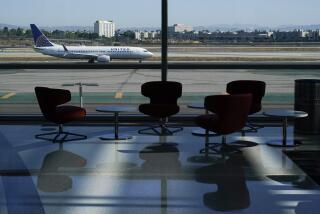O.C. Plans El Toro Airport Vote Despite Post-Attack Drop in Travel
As airports across the country postpone expansions in the wake of the Sept. 11 terrorist attacks, Orange County is moving ahead with a new airport on the unaltered assumption that demand for flights will double in the next 20 years.
The Board of Supervisors will vote Tuesday on final approval for a commercial airport at the former El Toro Marine Corps base, slated to become the second-largest airport in Southern California. It is uncertain how the board will vote. But up to now, a majority has supported a commercial airport at El Toro.
The plan would double Orange Countyâs air travel capacity by 2010 and more than triple it by 2020. John Wayne Airport handled about 7.8 million passengers last year; nearly the same number of Orange County travelers used either Los Angeles International or Ontario airports, according to a recent LAX passenger study.
The El Toro vote comes as the airline industry struggles to regain passenger confidence. Demand for travel at 11 airlines nationwide dropped as much as 45% in the last half of September, according to the Air Transport Assn. By the end of 2001, the annual passenger count at Los Angeles International Airport could fall 7% from last yearâs.
Industry problems appear to have bolstered El Toro opponentsâ argument that Orange County wonât need another airport in the next 20 years. Airport foes hope to ask voters in March to replace airport zoning at the base with plans for an urban park and university complex.
âGiven the events since Sept. 11, Orange County should concentrate on many issues that are more important,â said Paul Eckles, executive director of a coalition of south county cities opposed to an airport. âWe have enough airport capacity in Orange County to satisfy our share of demand.â
But preserving the ability to build an airport at El Toro is necessary for the future, supporters say, even if there is a short-term slowdown in travel. Supporters say some type of service, especially cargo flights, could be offered at the base in the next five years.
El Toro âis a futuristic opportunityâ beyond the next 10 or 15 years, said Bruce Nestande, president of Citizens for Jobs and the Economy. The group has backed the airport since 1993, when Congress voted to close the base.
âYou have to preserve the option for the long-term demand so you donât sit back 30 years from now and say, âWhy did we give that up,â â Nestande said. âWeâre talking about the next 50 years, not tomorrow.â
County officials had insisted that the new airport would open by 2005. But that was based on the property being turned over to the county by January 1999. The airport is at least three years behind schedule even if nothing else postpones it, including the March ballot measure and future lawsuits. The opening date is now 2006 at the earliest.
Industry analysts say it could take five years for the airlines to recover from the Sept. 11 attacks. Beyond free-falling revenues are the billions of dollarsâ worth of security upgrades required at the nationâs airports. Even before Sept. 11, airlines were struggling during a summer marked by corporate cost-cutting and an economic slowdown.
Carriers in the next few years will replace routes only if demand returns, and there will be less frequent service between destinations, analysts say. That already is being seen at outlying airports such as Ontario, where United Airlines dropped five daily flights from its schedule earlier this month.
Until recovery is complete, airlines simply arenât going to be eager to set up shop at a new, untested airport, where landing fees and passenger charges would be needed to back construction bonds, said Jack Kyser, chief economist for the Los Angeles County Economic Development Corp.
Other problems plague El Toro, he said, including an inefficient design that could cause some flights to sit for up to an hour on the runway before being cleared for takeoff, according to a review by the Federal Aviation Administration. Another is a committed and well-funded airport opposition movement that has managed to delay key project approvals.
âI am not that optimistic about El Toro,â Kyser said. âOn a scale of 1 to 10, Iâd give it a zero-point-two chance of being developed. There are just too many things out there that donât speak of anything happening there soon.â
Other analysts agreed that the travel downturn will eliminate near-term demand for more runways and airport space. But they also agreed that demand will rebound and could come back stronger in Southern California, an area that relies heavily on travel. That would add pressure for another Orange County airport.
âIt is hard to say if we will see the explosive growth of the past, but in Southern California, the demand for leisure and business travel has been enormous,â said Russell L. Goings, a senior vice president for West Coast operations of First Albany, which provides financial consulting for airports across the country.
Pent-up demand in Orange County will lead to the need for another airport, said Jessica Soltz, director of public and project finance for Fitch Inc., a Chicago-based bond-rating agency whose clients include 64 airports across the nation. But that need isnât imminent, she said.
âThere is not the demand today,â she said. âYou wonât be able to attract carriers to finance an expansion for a new airport. The airlines wonât be willing to pay for this right now.â
Orange County planners estimate that $1 billion in airline-based revenue bonds must be sold to build the airportâs first phase, which includes a terminal to handle 8.9 million passengers a year. So far, the majority of county supervisors backing El Toro favors capping its capacity at 18.8 million passengers.
Regional planners with the Southern California Assn. of Governments have expected airport demand in Southern California--excluding San Diego County--to grow by about 3.9% a year over the next 20 years. That number, calculated before the Sept. 11 attacks, takes regional passenger traffic from 89 million in 2000 to 158 million by 2020.
Agency officials said recently that despite the fallout from the terrorist attacks, they wonât revise their 20-year projections until 2004. By then, the effects on the industry will be known and a new set of 20-year projections can be adjusted accordingly, said Hassan Ikhrata, program manager for planning and analysis for the Southern California association.
Even so, the organization has projected that El Toro will handle 30 million passengers by 2020--substantially more than supervisors are prepared to accept. If Orange County restricts the airportâs size, âWeâll have to go back to the drawing board,â Ikhrata said.
El Toro airport activists have accused both the Southern California group and LAX officials of interpreting airport figures to address political agendas rather than establish accurate passenger counts. LAX officials, critics charge, have downplayed Orange Countyâs share of passengers to better justify an LAX expansion plan--which has been shelved. Conversely, SCAG has been accused of inflating the countyâs share to help promote the need for an airport at El Toro.
More to Read
Sign up for Essential California
The most important California stories and recommendations in your inbox every morning.
You may occasionally receive promotional content from the Los Angeles Times.











